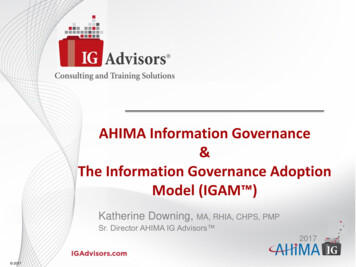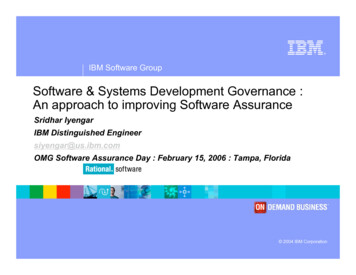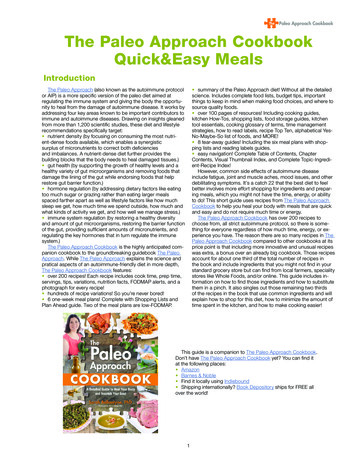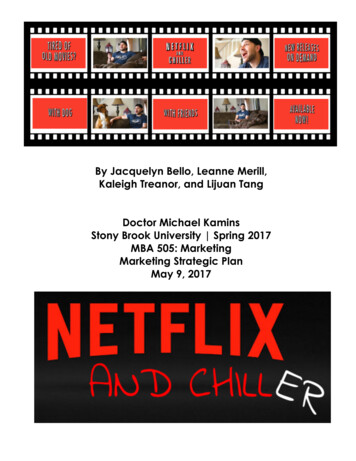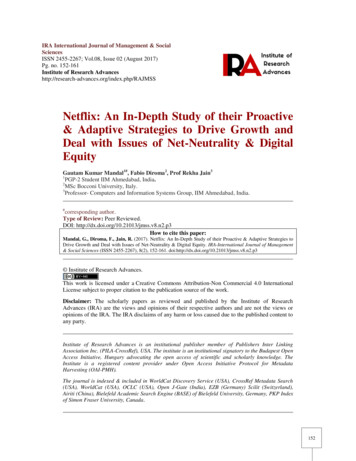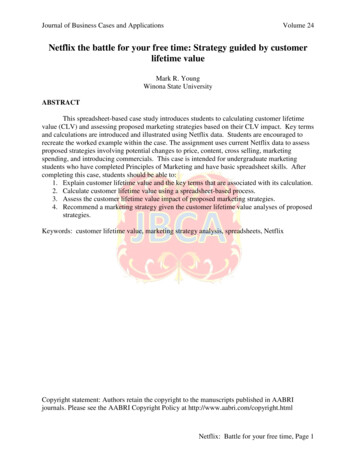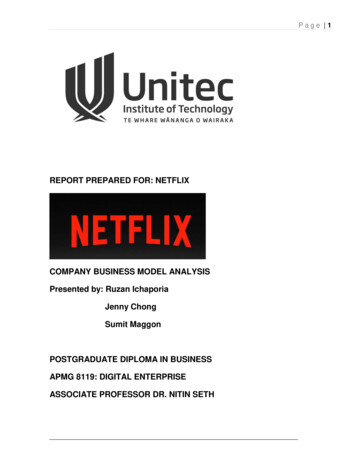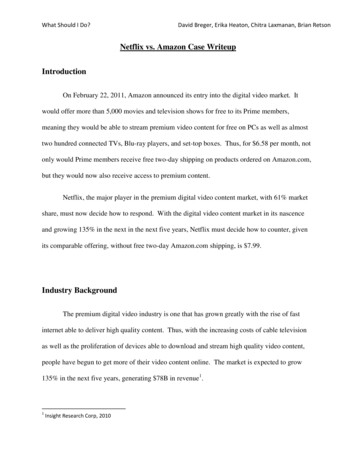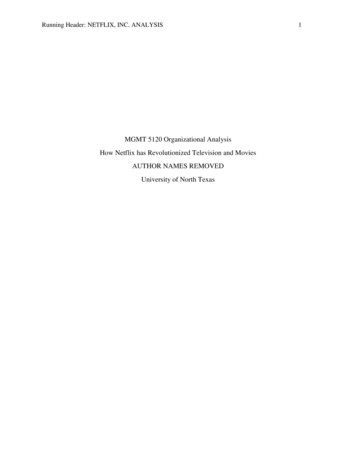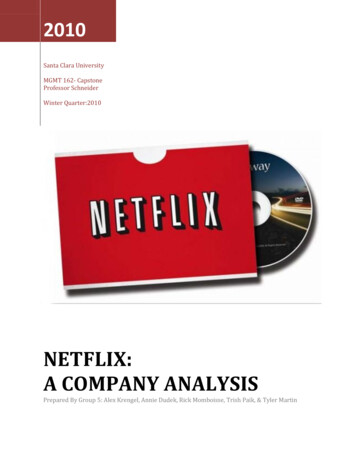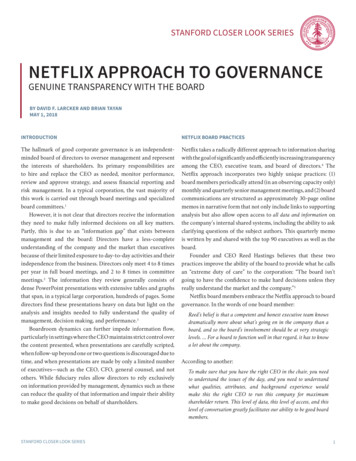
Transcription
Stanford Closer LOOK seriesNetflix Approach to GovernanceGenuine Transparency with the BoardBy David F. Larcker and Brian TayanMay 1, 2018introductionNetflix Board PracticesThe hallmark of good corporate governance is an independent-Netflix takes a radically different approach to information sharingminded board of directors to oversee management and representwith the goal of significantly and efficiently increasing transparencythe interests of shareholders. Its primary responsibilities areamong the CEO, executive team, and board of directors.4 Theto hire and replace the CEO as needed, monitor performance,Netflix approach incorporates two highly unique practices: (1)review and approve strategy, and assess financial reporting andboard members periodically attend (in an observing capacity only)risk management. In a typical corporation, the vast majority ofmonthly and quarterly senior management meetings, and (2) boardthis work is carried out through board meetings and specializedcommunications are structured as approximately 30-page onlineboard committees.1memos in narrative form that not only include links to supportingHowever, it is not clear that directors receive the informationanalysis but also allow open access to all data and information onthey need to make fully informed decisions on all key matters.the company’s internal shared systems, including the ability to askPartly, this is due to an “information gap” that exists betweenclarifying questions of the subject authors. This quarterly memomanagement and the board: Directors have a less-completeis written by and shared with the top 90 executives as well as theunderstanding of the company and the market than executivesboard.because of their limited exposure to day-to-day activities and theirFounder and CEO Reed Hastings believes that these twoindependence from the business. Directors only meet 4 to 8 timespractices improve the ability of the board to provide what he callsper year in full board meetings, and 2 to 8 times in committeean “extreme duty of care” to the corporation: “The board isn’tmeetings. The information they review generally consists ofgoing to have the confidence to make hard decisions unless theydense PowerPoint presentations with extensive tables and graphsreally understand the market and the company.”52that span, in a typical large corporation, hundreds of pages. Somedirectors find these presentations heavy on data but light on theanalysis and insights needed to fully understand the quality ofmanagement, decision making, and performance.3Boardroom dynamics can further impede information flow,particularly in settings where the CEO maintains strict control overthe content presented, when presentations are carefully scripted,Netflix board members embrace the Netflix approach to boardgovernance. In the words of one board member:Reed’s belief is that a competent and honest executive team knowsdramatically more about what’s going on in the company than aboard, and so the board’s involvement should be at very strategiclevels. For a board to function well in that regard, it has to knowa lot about the company.when follow-up beyond one or two questions is discouraged due totime, and when presentations are made by only a limited numberof executives—such as the CEO, CFO, general counsel, and notothers. While fiduciary rules allow directors to rely exclusivelyon information provided by management, dynamics such as thesecan reduce the quality of that information and impair their abilityto make good decisions on behalf of shareholders.Stanford Closer LOOK seriesAccording to another:To make sure that you have the right CEO in the chair, you needto understand the issues of the day, and you need to understandwhat qualities, attributes, and background experience wouldmake this the right CEO to run this company for maximumshareholder return. This level of data, this level of access, and thislevel of conversation greatly facilitates our ability to be good boardmembers.1
Netflix Approach to GovernanceBoard Attendance at Management MeetingsThe first element of the Netflix approach to governance is boardattendance at executive and senior executive meetings. Netflixholds three regularly scheduled executive meetings: Reed’s Staff meetings (R-Staff) are monthly meetings of thetop 7 executives to discuss the most important strategic andorganizational issues facing the company. Executive Staff meetings (E-Staff) are quarterly meetings ofthe top 90 executives consisting of presentations and breakoutsessions to review strategic issues, competitive threats,workplace issues, and policies. Quarterly Business Reviews (QBR) are 2-day gatheringsof the top 500 employees of the company that include aquarterly review of the business, presentations, crowd-sourceddiscussion topics, and group dinners.It just gives you a far better understanding of the company. Youget to know all of the operating players. You get a feel for the move,the cadence, how people think, how people contribute, how peopleinteract with each other. And of course, you get an understandingof the issues of the day.You see a different level of dynamic of the executive team. Youreally see how different individuals contribute, you see theirexpertise, you see the voice that they have around the table, andyou see the dynamic with the CEO. You see how the topics thathave been discussed, resolved, and reported on in a board meetingactually got processed.The fact that directors are invited to all those, and encouragedto come, and encouraged to meet and mingle with people up anddown the organization is unique and shows an immense amount ofconfidence on the part of the senior leadership.One board member attends R-Staff meetings, 1 to 2 attendNetflix directors believe that direct exposure to active strategic6E-Staff meetings, and 2 to 4 attend Quarterly Business Reviews.discussions gives them substantially deeper knowledge of theDirectors who attend these meetings are expected to observecompany than orchestrated visits to company offices or facilities.but not influence or participate in the discussion. AccordingOne director contrasts Netflix with another company whereto Hastings, “I don’t want the management meeting to be anyinteractions between the board and executives are “much moredifferent because they’re there.” Directors can follow up with thescripted, more formal, all very carefully orchestrated. This isCEO or other executives after the meetings with questions. Theydefinitely more natural.” In the words of a Netflix executive, “Reedare also free to share what they have learned with fellow boarddoesn’t try to edit us or tell us what to present.”members in subsequent board meetings.Beyond informing directors about the company, boardThe purpose of director attendance is primarily educational:attendance at senior executive meetings builds rapport and trustBy directly observing management, directors will have a greaterbetween the board and senior managers. It also positions theunderstanding of the range of issues facing the company, theboard well for an eventual CEO succession:analytical approach that underpins managerial decisions, andthe full scope of the tradeoffs involved. Ultimately, the aspirationis that this will translate to significantly more confidence inmanagement and its choices. According to Hastings:It’s an efficient way for the board to understand the company better.In the early days, it was mostly [to ensure] that if we got an overthe-top offer, the board wouldn’t sell too cheap, because they wouldreally understand and be confident that there is a long-term playhere. That was my motivation. Now, seeing how helpful it isfor them to do their role well, we’ve made it our standard practice.Board members have a very high understanding of what wouldmake for a great CEO of this company. We understand thelandscape, we understand how the company operates, etc. And sowhen we do get to a conversation about succession planning, thereis a high level of understanding. We would be starting from amuch better position.7Board Memos and Open Access to DataThe second element of the Netflix approach to governance is aboard memo with links to supporting analysis and open accessto all shared files on the company’s secured intranet. The boardBoard members value direct attendance of these meetingsmemo itself consists of 20 to 40 pages of written text thatbecause it increases their knowledge of the company and itshighlights business performance, industry trends, competitivemanagement:developments, and other strategic and organizational issues.8It’s a good opportunity for board members to see the team in actionand to meet several layers of the team. You end up with a morecommitted board, a more knowledgeable board, not people who justdrop in for dinner and a meeting.Stanford Closer LOOK seriesHigh-level data is summarized in charts and graphs, but thememo’s emphasis is primarily the written discussion and analysisof issues. Embedded links within each section of the memoconnect the reader to supplemental analysis, data, and details that2
Netflix Approach to Governancesupport and expand the written discussion.Board members receive the memo a few days prior to boardmeetings and are self-directed in reviewing the material andclicking through to review supplemental analysis on topics orissues they believe are most important, interesting, or require themost attention from a fiduciary standpoint. Directors estimatethey spend 4 to 6 hours in preparation, which is more than theyspend preparing for their other directorships but also claim it ismore interesting. They have the ability to pose questions or askfor clarification directly within the digital memo, to which seniormanagement responds prior to the meeting. Directors take active9advantage of this capability.According to Hastings:The memo is shared among all the VPs, the top 90 executives, andso it’s a way of alignment because I backbone it and captain it,but there are a bunch of sections written by the specialist in thefunctions. That is shared, the whole management team reads this,and they all have access to the board memo. Directors then havefull-view rights across the company’s documents, so they just clickand explore and click and explore to see the analysis of variousprograms. It’s all interconnected.According to David Wells, Netflix chief financial officer:[The board memo] is part of the evolution from a presentationculture to a memo-based culture [internally across the company].Once you have the ability to effectively write collaboratively, youcan then graduate to a memo that is collaboratively written. Thecentral coordinator, if there is one, is likely Reed himself or myFinancial Planning & Analysis group. Or, for each of the areasthat are writing these deeper memos, they have the C-level ownertake responsibility for that.Because directors are extensively prepared, board meetingsthemselves are significantly more efficient, with a focus onquestions and discussion rather than presentation. Meetingsare only 3 to 4 hours in length (compared to all day or multipleI think it makes a board more nimble. It makes the board moreconnected than they would otherwise be to the business, and it’smobile. I don’t have to be in a specific room to get information. Theinformation is always with me. I can always refer back.I’ve never seen anything like that with any other board that I’vebeen on. We’re exposed to a huge amount of information about thecompany. As a result, the board meetings are a relatively smallamount of presentation and a fair amount of questions, and thosequestions are pretty well informed.It’s not that the board memo is the board meeting. It isn’t. It’s all ofyour background reading before you go into the room so that youcan have an intelligent and informed conversation. People are upto speed when they show up.The general notion of open access, I think, is very useful across theboard. The degree to which you have access is the degree to whichyou can be helpful.It is a process that takes what is the accumulation of a hugeamount of data that is processed on a daily basis by the companyand distills it down in a consumable format for the board. It thenallows us to tease out the questions that are most important to thebusiness in the board meeting. It has made the board meetingsincredibly more efficient. Not everybody is a data-centric kindof thinker, and not everybody thinks well through slides, but almosteverybody thinks well through a narrative.Culture and LeadershipThe Netflix approach to board governance is rooted in andreflective of the company’s culture and leadership. TheNetflix culture emphasizes individual initiative, the sharingof information, and a focus on results rather than processes.11According to David Hyman, the company’s general counsel:Our culture deck and the way in which we operate with the boardare intertwined. Everything from “freedom and responsibility,”“candor,” “context not control,” and “transparency.” All of thoseplay together and work well. It would be incongruous to have thisinteresting culture and then have a board that was kept in a box.12days at many large corporations). They begin with the CEO anddirectors listing the main questions on a white board and proceedBoard members speak very highly of the company culture and itsimmediately to discussion. Senior executives attend boardapplication to the boardroom:meetings and answer questions if needed.10Netflix directors are very positive about the level of informationthey receive through the memo and supporting analysis, and theimpact that these have on board meetings and discussion:Stanford Closer LOOK seriesReed has always been masterful at hiring really good people,pushing decision making to those people, and not micromanaging.Letting decisions roll up and be debated rather than micromanaged.That style, that kind of management philosophy rolls up into theboard meetings where any one of the
netflix Board Practices Netflix takes a radically different approach to information sharing with the goal of significantly and efficiently increasing transparency among the CEO, executive team, and board of directors.4 The Netflix approach incorporates two highly unique practices: (1) board members periodically attend (in an observing capacity only)File Size: 219KBPage Count: 7

